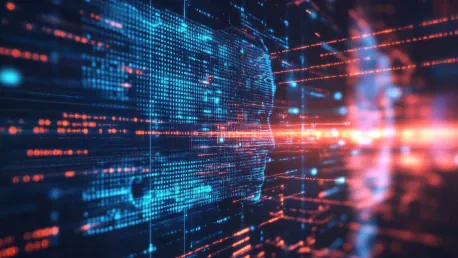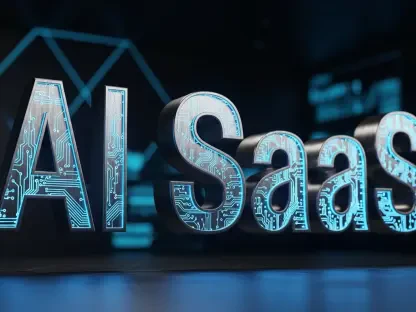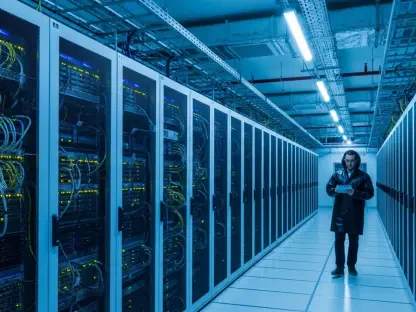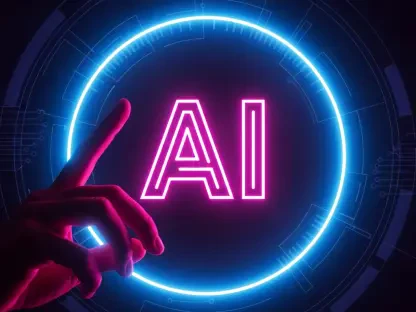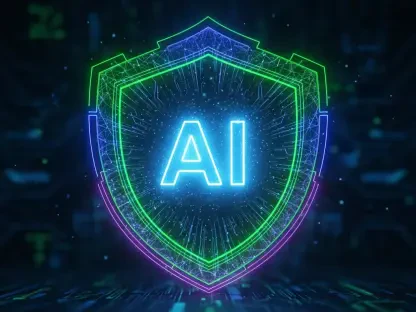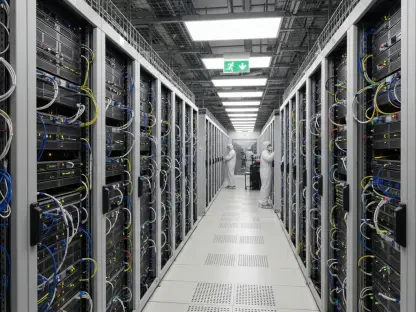As the landscape of cyber threats continues to evolve, Australian businesses are increasingly recognizing the limitations of traditional DevOps approaches in safeguarding their operations. With 70% of organizations acknowledging that AI advancements are outpacing their cybersecurity defenses, the need for AI-integrated DevSecOps has never been more urgent.
The Rise of AI in DevSecOps
Integrating Security at Every Stage
DevSecOps, a fusion of DevOps, SecOps, and ITOps, emphasizes embedding security into every phase of the software development lifecycle. By incorporating AI into this mix, businesses can significantly enhance their security measures and operational efficiency, thereby achieving greater cyber resilience. As cyber threats grow in sophistication, the traditional methods of separate stages for development, operations, and security are proving inadequate. An integrated approach ensures that security is not an afterthought, but a crucial component from the initial stages of development.
The integration of AI into DevSecOps transforms the software development lifecycle, ensuring vulnerabilities are addressed at every step. This proactive approach is essential in today’s fast-paced digital environment, preventing potential breaches before they can be exploited. By automating security checks and employing AI-driven analytics, this fusion allows developers and security experts to collaborate more efficiently. This collaboration leads to more resilient and secure software, reducing the risks and costs associated with late-stage vulnerability detection. Consequently, businesses can focus on innovation and growth unhindered by security concerns.
Early Detection and Collaboration
One of the primary benefits of AI-powered DevSecOps is the redefinition of development and testing processes. Automated security integration facilitated by AI ensures that vulnerabilities are identified and addressed early, promoting collaboration between development, quality, and security teams and reducing costly errors later. By enabling early detection of potential security issues, AI-driven tools provide a safety net that traditional DevOps lacks. Early-stage problem-solving eliminates the need for extensive reworking, which is costly and time-consuming, conserving resources and enhancing productivity.
Furthermore, AI’s ability to analyze vast amounts of data swiftly means that it can spot patterns and anomalies that might be missed by human eyes. This capacity for detailed analysis and pattern recognition is invaluable in identifying and addressing vulnerabilities that could otherwise lead to significant security breaches. The integration of AI in DevSecOps thus fosters a culture of collaboration and continuous improvement, where team members across various disciplines come together to ensure the highest security standards. This collaborative effort not only fortifies the software against potential threats but also accelerates the development process by streamlining workflows and reducing friction between teams.
Enhancing Operational Efficiency
Minimizing Redundant Activities
AI-driven DevSecOps boosts development stage efficiency by minimizing redundant activities, allowing skilled engineers to focus on more complex tasks. Automated testing and security checks conducted earlier in the process result in more reliable software, unlike the traditional approach where such checks are performed towards the end. The redundancy commonly found in traditional development processes often leads to bottlenecks and delays, hampering overall productivity. By employing AI, these redundancies can be systematically identified and eliminated, paving the way for a leaner, more effective development process.
The benefits of minimizing redundant activities extend beyond mere efficiency. When engineers are freed from repetitive tasks, they can dedicate their expertise to solving intricate problems, pushing the boundaries of innovation. Automation through AI ensures that routine security checks and tests are performed with precision and consistency, drastically reducing the probability of human error. This leads to a more streamlined workflow, where every team member’s focus can shift from mundane tasks to strategic initiatives that drive the company’s growth forward. The result is a more agile and responsive organization that can adapt swiftly to changing market dynamics and emerging threats.
Reducing Technical Debt
Technical debt, often overlooked until it significantly impacts an organization, hampers innovation and growth. AI-driven automated testing within DevSecOps continuously scans code for inefficiencies and vulnerabilities, facilitating their early detection and resolution, thus reducing technical debt. Addressing technical debt proactively is crucial for maintaining the long-term health of the software and the organization as a whole. Ignoring this aspect can lead to compounded issues that require extensive resources to rectify later on, impeding the company’s ability to innovate.
Through continuous monitoring and automated testing, AI ensures that technical debt is not only identified but also prioritized efficiently. Real-time insights provided by AI-driven tools can offer actionable recommendations, allowing teams to focus on the most critical issues first. This prioritization is essential for maintaining a balance between new development initiatives and necessary maintenance work. By systematically reducing technical debt, organizations can enjoy greater operational efficiency, unburdened by the drag of accumulated inefficiencies. This fosters a culture of continuous improvement where innovation is not stifled by underlying issues, enabling sustained growth and competitiveness in a fast-evolving digital landscape.
Combating AI-Powered Cyber Threats
The Dual Fate of AI in Cybersecurity
AI is a double-edged sword in cybersecurity, serving both as a powerful defense tool and an asset for cybercriminals. The Australian Signals Directorate’s Annual Cyber Threat Report highlights the increasing use of AI by malicious actors for sophisticated attacks, including personalized emails, deep fakes, and data poisoning. The dual nature of AI in cybersecurity underscores the urgency for businesses to adopt advanced measures to stay ahead of malicious activities. While AI-driven solutions can fortify defenses, they also necessitate vigilance and continuous improvement to mitigate the evolving tactics employed by cybercriminals.
The use of AI by cybercriminals to enhance the precision and impact of their attacks presents an escalating challenge. Personalized phishing emails that appear legitimate, AI-generated deep fakes, and sophisticated data manipulation tactics require highly responsive and adaptive defense mechanisms. For Australian businesses, the implication is clear: reactive security measures are no longer sufficient. Proactive, AI-driven security practices must be embedded deep within organizational processes to anticipate and counteract these advanced cyber threats. This demands not only advanced technological investments but also a shift in the cybersecurity culture within organizations, ensuring that every employee understands the potential threats and their role in maintaining security.
The Need for AI-Driven Security Measures
Given the adaptive nature of AI-powered attacks, businesses must implement AI-driven security measures to effectively combat advanced threats. AI-powered security solutions excel in identifying subtle anomalies in user behavior or network traffic, offering early threat detection and preventing potential damage. This preemptive approach, crucial in the current landscape, means that organizations can stay a step ahead of would-be attackers, identifying and blocking threats in their nascent stages. The capability to analyze enormous datasets in real-time allows AI to pinpoint irregularities that might indicate a breach, ensuring a robust and responsive security framework.
The necessity for AI-driven security measures is further emphasized by the increasing complexity of cyber threats. Traditional security systems lag behind in their ability to detect and respond to these sophisticated threats. The implementation of AI-driven tools provides an unmatched level of vigilance, continuously learning from past incidents and adapting to emerging threats. In this way, AI acts as both a shield and a spear, fortifying defenses while also enabling organizations to launch precise countermeasures against cybercriminals. This holistic approach is vital for fostering a resilient cybersecurity posture that can withstand the relentless evolution of cyber threats.
The Path Forward for Australian Businesses
Accelerating AI-Driven DevSecOps Adoption
The growing cybersecurity threats necessitate an accelerated adoption of AI-driven DevSecOps initiatives. Organizations must stay ahead in the cybersecurity arms race by embracing these advanced strategies to ensure robust security and efficient software development. The urgency of adopting AI-powered DevSecOps cannot be overstated given the rapid advancements in both technology and the sophistication of cyber threats. Businesses that fail to evolve their security measures in tandem with these threats risk significant vulnerabilities that could be exploited by malicious actors, leading to potential financial and reputational damage.
For Australian businesses, the path forward involves not only implementing advanced technologies but also fostering an organizational culture that prioritizes cybersecurity at every level. Training and development programs must be established to enhance the cybersecurity skills of the workforce, ensuring that employees are equipped to handle the complexities of modern cyber threats. By embedding a culture of continuous improvement and vigilance, organizations can create a robust defense mechanism that leverages AI-driven insights to stay ahead of potential threats. The strategic adoption of AI-powered DevSecOps will enable businesses to maintain a competitive edge, ensuring that security measures evolve in lockstep with technological advancements.
The Future of Cybersecurity
As cyber threats continue to advance, Australian businesses are becoming increasingly aware of the shortcomings of traditional DevOps methods in protecting their systems. Traditional DevOps, while effective for development and operations, often lacks the robust security measures needed to combat modern cyber threats. The rapid pace of technological advancements, particularly in AI, is outstripping the capabilities of many current cybersecurity strategies. Indeed, 70% of organizations report that advancements in AI are surpassing their cybersecurity defenses, creating a significant gap in security. This stark reality underlines the urgent need for incorporating AI into DevSecOps. By integrating AI into DevSecOps, businesses can better anticipate and counteract evolving cyber threats. AI-enhanced DevSecOps provides a more proactive and dynamic approach to security, ensuring that both development and operations are protected against potential vulnerabilities. This level of integration is essential for businesses aiming to stay ahead of cyber threats and secure their operations effectively.
